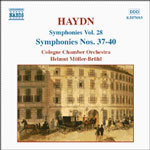
Haydn: Symphonies Vol 28 (Nos. 37 - 40)
 $25.00
Out of Stock
$25.00
Out of Stock6+ weeks add to cart
JOSEPH HAYDN
Haydn: Symphonies Vol 28 (Nos. 37 - 40)
Cologne Chamber Orchestra, Helmut Muller-Bruhl (conductor)
[ Naxos / CD ]
Release Date: Friday 6 June 1997
This item is currently out of stock. It may take 6 or more weeks to obtain from when you place your order as this is a specialist product.
Franz Joseph Haydn was born in the village of Rohrau in 1732, the son of a wheelwright. Trained at the choir-school of St Stephen's Cathedral in Vienna, he subsequently spent some years earning a living as best he could from teaching and playing the violin or keyboard, and was able to profit from association with the old composer Porpora, whose assistant he became.
Haydn's first appointment was probably as early as 1758 as Kapellmeister to a Bohemian nobleman, Count von Morzin, whose kinsman had once served as patron to Vivaldi. This was followed in 1761 by employment as Vice-Kapellmeister to one of the richest men in the Empire, Prince Paul Anton Esterházy, succeeded after his death in 1762 by Prince Nicolaus. On the death in 1766 of the elderly and somewhat obstructive Kapellmeister Gregor Werner, who had found much to complain about in the professionalism of his young and resented deputy, Haydn succeeded to his position, to remain in the same employment, nominally at least, for the rest of his life.
On the completion of the magnificent palace at Esterháza in the Hungarian plains under Prince Nicolaus, Haydn assumed command of an increased musical establishment. Here he had responsibility for the musical activities of the palace, which included the provision and direction of instrumental music, opera and music for the theatre, as well as music for the church. For his patron he provided a quantity of chamber music of all kinds, particularly for the Prince's own peculiar instrument, the baryton, a bowed string instrument with sympathetic strings that could also be plucked.
Prince Nicolaus died in 1790 and Haydn found himself able to accept an invitation to visit London. There he provided music for concert seasons organized by the violinist-impresario Salomon. A second successful visit to London in 1794 and 1795 was followed by a return to duty with the Esterházy family, the new head of which had settled principally at the family property in Eisenstadt, where Haydn had started his career with them. Much of the year, however, was to be spent in Vienna, where Haydn passed his final years, dying in 1809, as the French armies of Napoleon approached the city yet again.
Haydn lived during the period of the eighteenth century that saw the development of instrumental music from the age of Bach and Handel to the era of the classical sonata, with its tripartite first-movement form and complementary two or three further movements, the former the basis now of much instrumental composition. The symphony may claim to have become the most important form of orchestral composition and owes a great deal, if not its precise paternity, to Haydn. He first attempted such composition some time before 1759 and wrote his last symphonies for London in the last decade of the century.
Tracks:
Symphony No. 37 in C major
Symphony No. 38 in C major
Symphony No. 39 in G minor
Symphony No. 40 in F major

